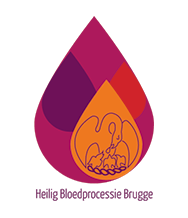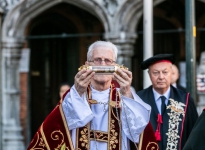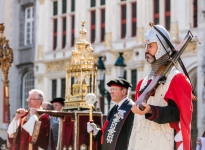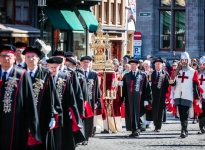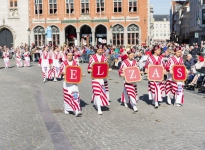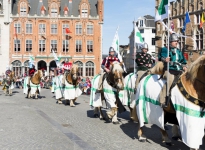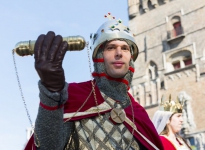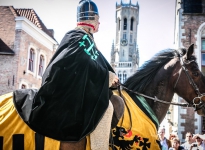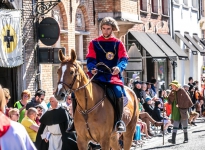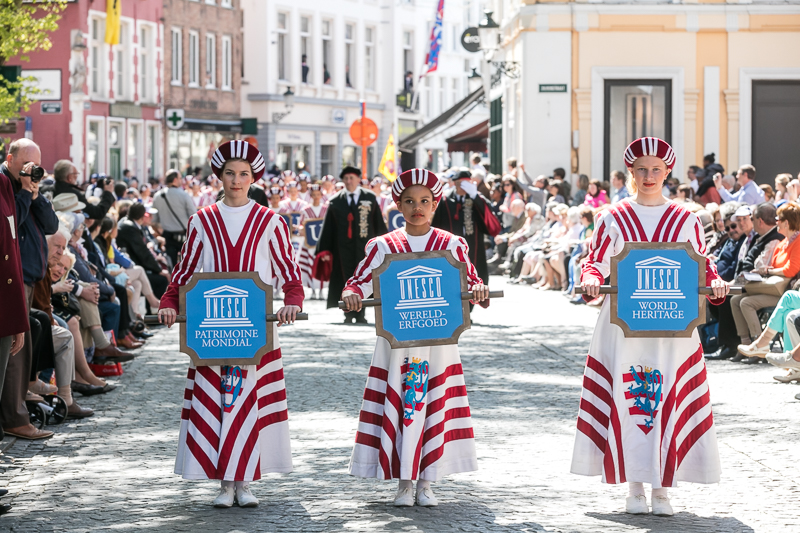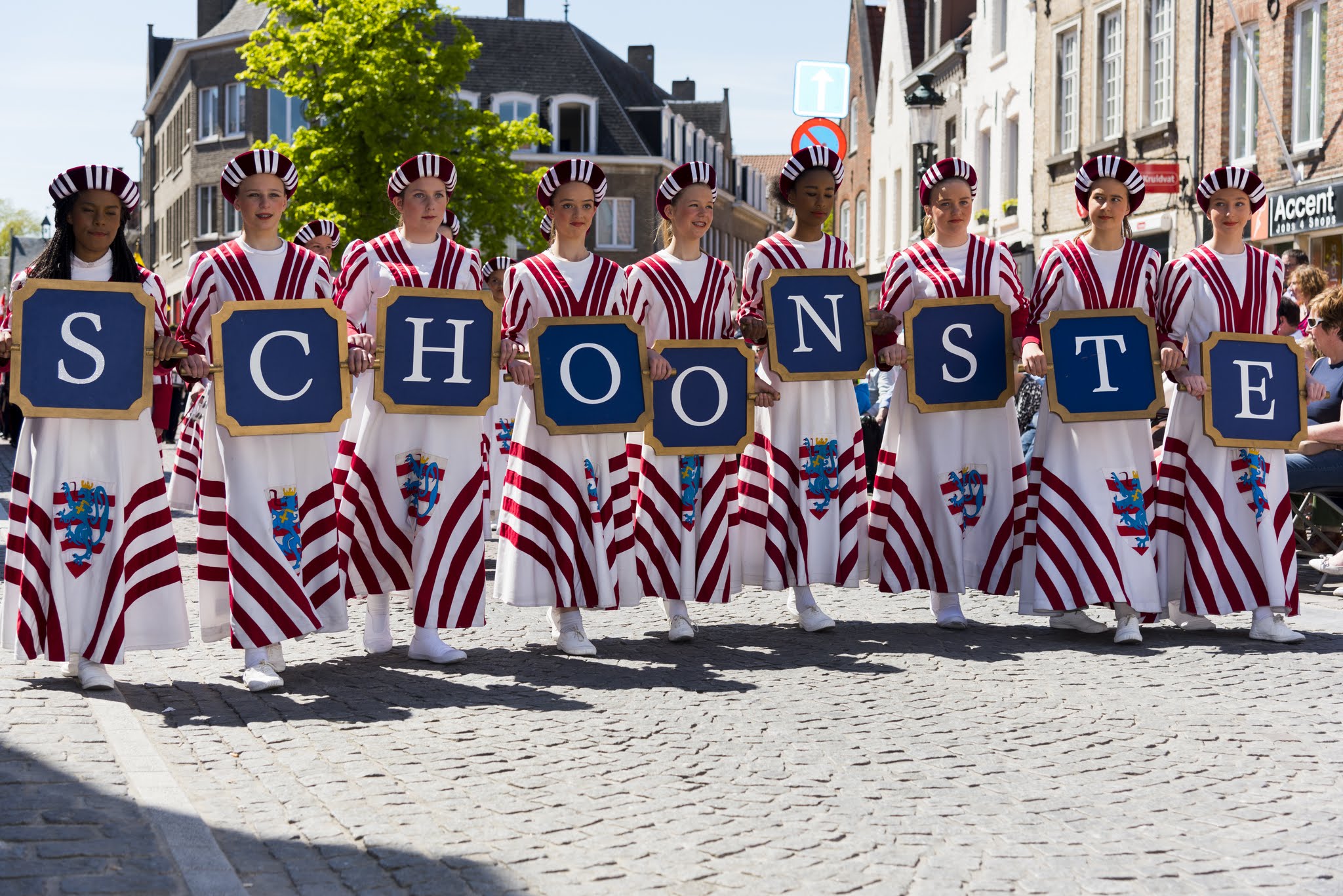History
The creation of the Procession of the Holy Blood
The earliest mention of the Procession of the Holy Blood can be found in a charter of the Guild of Pijnders (unloaders) dating back to 1291. This showed the Bruges guilds and crafts were required to participate with the procession. There was probably already a moment before 1291 when the relic of the Holy Blood was shown to the public in the chapel on the Burg. The procession was presumably started as a result of this custom.
Procession of the Holy Blood
People spoke of a Procession of the Holy Blood, which took place around the city walls, from 1303. The procession turned into an official civil event, as the relic was city property, whereby riders, crafts and guilds, marksmen, city councillors and, of course, the clergy with the relic paraded around in all their splendour.
The Bruges city authorities decided for the festivities around the Holy Blood – the procession and the fortnight of ceremonies – to coincide with the annual market (the Meifoor) from 1310 onwards. That is still the case today. This ensured the support and devotion for the Holy Blood grew, also as a result of the city councillors who crossed Flanders.
Evolution in the 15th and 16th century
In addition to the biblical scenes (mystery plays), secular scenes with giants (the magical horse Bayard and the Four Sons of Aymon) and the chambers of rhetoric also appeared in the procession in the 15th and 16th century. People thought it was safer not to take the relic outside of the city gates as a result of the religious uprising (1578) and the procession took place ‘intramural’ for the first time, within Bruges’ walls. Bruges had a Calvinistic administration between 1578 and 1584. The procession was suspended and the relic was brought to safety.
Procession in the 17th, 18th, 19th and 20th century
The procession was given back its religious character during the time of the Counter-Reformation (17th century), as well as during the 18th century. Floats with all kinds of symbols and images gave the procession a triumphant character. The Procession of the Holy Blood was interrupted once again during the French domination (1796-1819) and the relic was safely hidden once more.
The procession was composed by the city’s seven parishes in the 19th century, with its numerous brotherhoods, congregations and schools. The procession went through some major changes where its content and presentation was concerned during the 20th century.
The procession today
Up until today we have worked on innovation every single year (new floats, new customers, new scenes, …).
Today the procession is interpreted in a style which harks back to Bruges’ Golden Century (15th century). Back then Bruges was one of the most important harbours to the North of the Alps, plus it was also a busy trade market, as well as the residence of the Dukes of Burgundy. Some remarkable works were produced during that period (including the Flemish Primitives).
Legend
Relic of the Holy Blood
According to late medieval tradition, the Flemish Count Thierry of Alsace (ca. 1099-1168) brought the relic of the Holy Blood from Jerusalem after the Second Crusade. Thierry was supposed to have been given the relic by Jerusalem’s Patriarch, as a mark of appreciation for his heroism during the Crusade. His brother in law, Baldwin III of Anjou, was King. Count Thierry brought the relic to the Sint-Baseliuskapel on the Burg on 7th April 1150. He was accompanied by his wife Sybilla of Anjou and by Leonius, the Abbot of the Sint-Bertijnsabdij in Saint-Omer.
Thierry of Alsace, Count of Flanders
The Flemish Count Charles the Good was murdered in the Sint-Donaaskerk in Bruges (located on the Burg at that time) on 2nd March 1127. He had no direct heir. Two candidates were preparing for the throne: William Clito, supported by the French King Louis VI and Thierry of Alsace. William became the new Count against Flanders’ wishes on 23rd March 1128. Thierry, whose mother was the Flemish Count Robert’s daughter, was able to count on support from both the Flemish nobles as well as the cities of Bruges, Ghent, Lille and Saint-Omer. The battle wasn’t long in coming and William Clito died in front on the gates of Aalst on 27th July 1128. This allowed Thierry to now take power. Both Louis VI as well as the English King Henry I acknowledged Thierry as the new Count of Flanders.
Thierry was the son of Duke Thierry II of Upper Lorraine and of Gertrude of Flanders, daughter of Robert I of Flanders. Under his reign Thierry held a neutral position towards France and England, who were at war with each other. This neutrality was good for Flanders.
Thierry first married Swanehilde, who already died in 1132. She gave him a daughter, Lauretta. The Count often travelled to the Holy Land. He did so in 1138, to marry Sybilla of Anjou a year later, daughter of the King of Jerusalem. Thierry had seven children with Sybilla and three illegitimate children. Thierry took part in the Second Crusade in 1148. Sybilla stayed in Flanders and had to hold off Baldwin IV, Count of Hainaut, who was trying to win over Flanders. Thierry returned and made peace with Baldwin IV. Thierry travelled to the Holy Land again in 1157, this time together with Sybilla. Their son Philip remained as Regent in Flanders. Sybilla decided to enter the convent in Jerusalem when Thierry travelled back to Flanders in 1160. He returned to the Holy Land for a two year period in 1164. Philip succeeded his father in 1168. Thierry of Alsace was buried in the Abbey of Watten.
A legend
The story is beautiful but doubtful. Alongside Rome and Santiago de Compostela, Jerusalem, with its Holy Sepulcher, the Via Dolorosa and other places which remind us of Jesus’ suffering and death, is an important pilgrimage location. We have been provided with a variety of different written pilgrim stories, but none of these mention a Holy Blood Relic in Jerusalem. This is quite remarkable, to say the very least. Another extraordinary fact is the date: if the relic was brought to Bruges in 1150, why does the first trace of the presence of the Holy Blood in Bruges date back to 1256?
Pillaging in Constantinople
One historic fact is that, in Constantinople, a relic of the Holy Blood was preserved in the Mariakapel at the Imperial Palace Bucoleon. This chapel was home to several relics around the suffering and death of Christ: the crown of thorns, the lance, a piece of the cross, the nails, the shroud … The Venetians were able to persuade the crusaders to first attack Constantinople, Venice’s rival, on their way to Jerusalem during the Fourth Crusade. The crusaders took the imperial city in 1203, which was followed by pillaging lasting three days (1204). Whilst the Venetians took all sorts of artwork to enrich their San Marco Basilica, one of the Crusade’s leaders, Baldwin IX, Count of Flanders, was appointed as Constantinople’s new Emperor.
Presumably the looted relics subsequently ended up in Flanders, and more specifically the Holy Blood in Bruges. After all, his daughters Johanna and Margaretha were at the head of the county. The way in which the rhinestone bottle – which the coagulated blood was stored in – was cut also refers to Constantinople.
World Heritage
The Intergovernmental Committee of UNESCO decided to protect the intangible heritage and include the Bruges Procession of the Holy Blood on the list of Masterpieces of the Oral and Intangible Heritage of Humanity on 30th September 2009, during a meeting in Abu Dhabi.
Bruges’ most beautiful day
Many Bruges residents haven’t spoken about Ascension Day for many years, but instead like to refer to it as ‘Holy Blood Day’. We see this as a clear illustration of the enthusiasm Bruges is brimming with on its ‘most beautiful day’!
 English
English Nederlands
Nederlands  Français
Français  Deutsch
Deutsch  Español
Español 